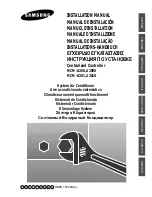
3-7
THE HOT START SENSOR
Under cold room conditions, (50
°
F, or below),
the Hot Start Sensor turns on the heater strips
with a call for heat to distribute warm air at the
beginning of the “Heat” cycle. Once the return
air has warmed sufficiently, (above 65
°
F), the
heat pump mode will begin.
THE HEAT PUMP
The heat pump uses backup electric resis-
tance heating coils. At extremely low outdoor
ambient temperatures, the heat pump is auto-
matically disabled, and the unit operates solely
on electric resistance heat.
The heating control (defrost thermostat) is lo-
cated behind the decorative front cover, and is
found on the right side panel of the chassis. Its
function is to allow the temperature range in
which the heat pump operates to be manually
adjusted.
The heating control switches the unit’s heat
operation between the heat pump, and electric
resistance heat, based on the outdoor ambient
temperature. These change-over temperatures
are based on the settings of the control. The
factory set-point is at the one o’clock position.
If you wish to change the factory set-point,
insert a flat-bladed screwdriver into the slot and
turn counterclockwise to increase the change-
over set-point, or clockwise to decrease it.
NOTE:
Use the factory set-point for optimum
performance.
Emergency Heat Operation Only:
In the event
of a compressor malfunction in the “heat pump”
mode, turn the adjustment screw to the ex-
treme counterclockwise “emergency heat” po-
sition. The heater will then cycle using electric
resistance heat only. Note that in the emer-
gency heat position, the compressor is locked
out, disabling both the heat pump, and the
cooling operations.
IMPORTANT:
Do not for-
get to return the control to its original position
after repairs have been made. Otherwise, the
compressor will remain locked out, and will not
turn on during the “cooling” mode.
Adjustment
Screw
Heat Pump Function
Summary of Contents for ATE0743RPP
Page 20: ...2 12 NOTES ...
Page 30: ...3 10 NOTES ...
Page 71: ...7 5 WIRING DIAGRAMS DIAGRAM 1 ...
Page 72: ...7 6 DIAGRAM 3 DIAGRAM 2 ...
Page 73: ...7 7 DIAGRAM 4 DIAGRAM 5 ...
Page 74: ...7 8 DIAGRAM 7 DIAGRAM 6 ...
Page 75: ...7 9 DIAGRAM 8 ...
Page 84: ...7 18 NOTES ...
Page 90: ...8 6 NOTES ...
Page 92: ...CORPORATION ...
















































